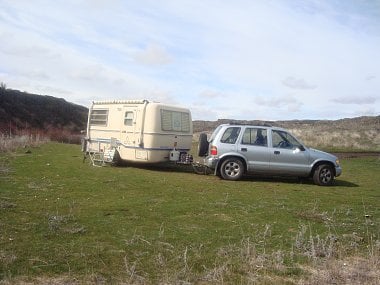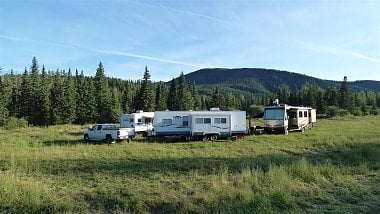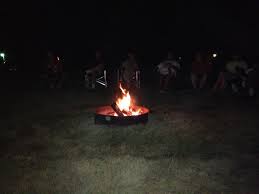Dispersed free camping on public lands is a great option to avoid crowds, save money on summer RV adventures and makes the most of your self-contained RV.
Dispersed camping means thinking outside the campground and creating your own perfect campsite on the millions of acres of public land available to U.S. taxpayers. It’s easy to do but there are some rules to follow. You can avoid the wrath of the park ranger by following a few simple common sense tips.
Where to Set Up Your Free Campsite
Before you set up your free campsite on some scenic spot, do some simple research. Start by scanning a good map to narrow down your camping location choices and see what, if any, public lands are available. Most recreation areas will be noted on the map with the managing agency’s name alongside it.
If you’re in the West, the Bureau of Land Management has millions of acres for your recreation enjoyment, all at no charge to you. Other options beyond the West include state-run Department of Wildlife / Natural Resources agencies, U.S. Forest Service managed lands and miscellaneous state-owned public recreation areas.
Consult the website Recreation.gov to find public lands near you, or do a web search for “Free camping areas in: _____” to find out more about camping options and which agency manages the land where they’re located.
Thanks to the Internet, very few free camping areas in the U.S. remain a secret. Some are more well-loved than others, but a good Internet search will usually reveal a lot of information on your desired location.
How to Set Up Your Free Campsite
Just because the camping is free doesn’t mean you can do whatever you like. One of the biggest limitations across all land management agencies is a time limit on free camping. These time limits can range from 7 to 16 days depending on how much use the region gets. If you want to stay longer, generally you won’t break any laws if you pack up your campsite and move to a different spot in another section of the recreation area. To know for sure, always get an official answer by consulting posted campground rules or asking a local official.
Once you arrive at your perfect free campsite, look around and be respectful if you’re near other campers. If there is enough room to spread out, do it. Remember, the forest is for everyone but nobody wants to hear their neighbor’s generator droning all hours of the day. For ultimate courtesy in the wild, invest in a good solar electric power system.
Because you’re dry camping without hookups, you will have to carry out what you brought in. Use water sparingly and never dump waste water on the ground. Doing so could earn you a hefty fine so don’t do it.
Campfires are also off-limits in many areas, especially in the drought-stricken West. Check with local officials about current fire restrictions and if you start a campfire, use caution and follow all rules for open camp fires.
Once you do it a few times you’ll learn the ropes of dry camping and discover that free camping on public lands is a great way to escape civilization. When you’re out there, at least you’ll know for sure that your tax dollars are being put to good use.




Great article! As long as you don’t mind solitude, some of the most beautiful scenery in the West is yours for free on Forest Service and BLM land. And, if you don’t like solitude, there is always free or very low-cost, long-term camping in the desert around Quartzite, Arizona every winter. Your Website links are certainly a start, but don’t stop there.
Even in places like the mountains of Colorado during the peak summer camping season, there are free dispersed campsites, and even dry campsites with some amenities (water, pit toilets, picnic tables, and/or fire pits), available for those who spend a little time doing some research. For those planning a trip to Colorado next summer, take a look at https://2fanrgs.blogspot.com/ for additional route and camping ideas.